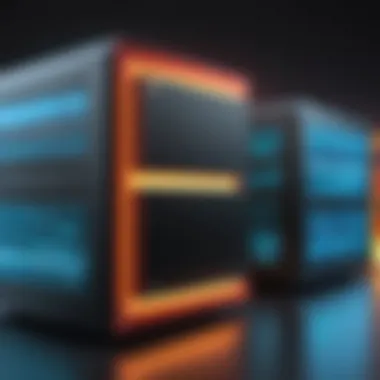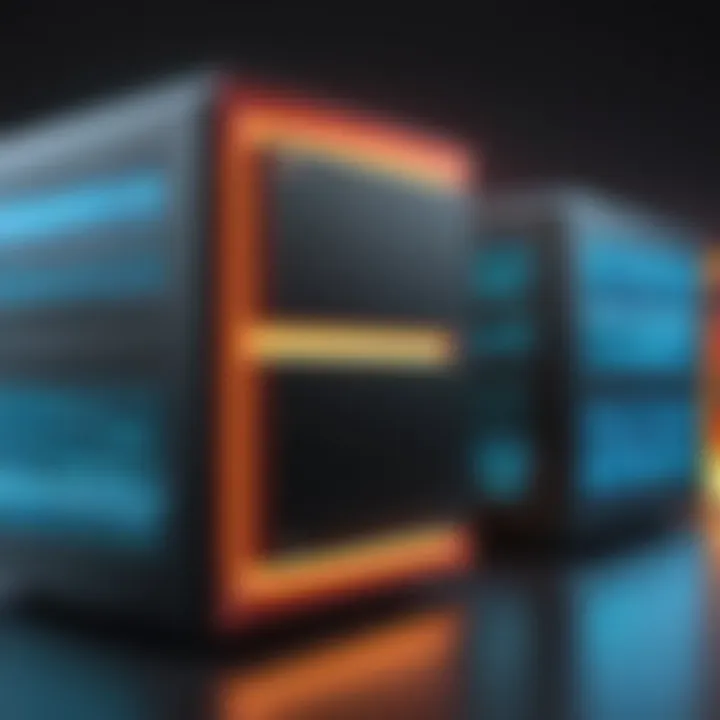Top Firewall Solutions for Personal Computers


Intro
In today’s digital age, where online threats loom large and data breaches make headlines, the need for robust security on personal computers is more imperative than ever. Firewalls stand as a first line of defense in this battlefield, acting as gatekeepers between your computer and the vast expanse of the internet. They can manage traffic, block malicious data, and keep prying eyes at bay.
However, not all firewalls are created equal. It’s crucial for users—whether they're IT professionals, cybersecurity experts, or students—to grasp not only the variety of firewall options available but also the fundamental concepts behind networking, security, and storage.
This section aims to bridge that gap, providing insights into essential terminologies and concepts that can empower users to navigate the often-complex landscape of firewall technologies. With a clearer understanding, readers can make informed choices that bolster their PC security, ensuring their data remains safe amidst the ever-evolving threats of the online world.
Understanding Storage, Security, or Networking Concepts
Prelude to the basics of storage, security, or networking
When it comes to safeguarding your digital realm, understanding the basics of storage, security, and networking is paramount. Firewalls operate at the intersection of these domains, forming a protective barrier.
Storage refers to locations where data is kept, retrievable when needed. This can include hard drives, SSDs, and cloud-based solutions, each comes with specific security challenges.
Security encompasses the measures taken to protect information from unauthorized access and cyber threats. A sound understanding of security protocols helps in configuring firewalls effectively.
Networking involves the communication between computers and how resources are shared across various networks. A solid grasp of networking fundamentals enables better firewall management, helping to control incoming and outgoing traffic efficiently.
Key terminology and definitions in the field
Diving deeper, one encounters several terms that are pivotal in the realm of firewalls:
- Packet Filtering: This is a method used by firewalls to analyze network packets based on predefined rules, deciding whether to allow or block them.
- Stateful Inspection: Unlike packet filtering, stateful inspection keeps track of the state of active connections and determines which packets to allow based on their context.
- Proxy Service: Acting as a mediator, a proxy firewall prevents direct contact between the user and the internet, adding another layer of security.
- VPN (Virtual Private Network): While not a firewall per se, a VPN helps secure user data, enabling encrypted communication over less secure networks.
Overview of important concepts and technologies
Understanding these concepts sets the groundwork for selecting the right firewall. Here are some technologies that are essential in constructing a secure digital environment:
- Application Layer Filtering: This firewall function monitors specific applications, blocking harmful requests targeting software vulnerabilities.
- Intrusion Detection Systems (IDS): These systems analyze network traffic for suspicious activities and alert administrators to potential threats.
- Next-Gen Firewalls (NGFW): They combine traditional firewall features with advanced capabilities like deep packet inspection and intrusion prevention.
"In cybersecurity, understanding the lingo is half the battle won. Knowledge is a shield more effective than any software you might purchase."
With these foundational elements in mind, it becomes easier to sift through the myriad of firewall options, evaluating them through the lenses of security needs and specific functionalities.
Understanding Firewalls and Their Importance
In today’s interconnected world, where each click can lead to potential risks, understanding firewalls becomes vital. These digital sentinels act as the first line of defense against numerous cybersecurity threats, from data breaches to malicious attacks. Throughout this article, we will dissect various firewall options available for PCs, illuminating their relevance in a landscape rife with cyber dangers. By fathoming how they function and their roles in safeguarding sensitive information, we pave the way for informed decision-making on personal computer security.
Definition and Functionality
A firewall can be viewed as a barrier between a trusted internal network and untrusted external networks, such as the vast realm of the internet. At its core, it is a security mechanism that governs the flow of incoming and outgoing traffic based on a set of predefined security rules. Imagine it as a kind of checkpoint, filtering what is allowed to enter or leave your digital home.
The primary function of a firewall is to prevent unauthorized access while permitting legitimate communication. This is crucial for maintaining the integrity of a personal computer. Firewalls can also log traffic data, alerting users to suspicious activity that might need further investigation.
Types of Firewalls
Understanding the different types of firewalls is essential for choosing the correct one to meet your security needs. Each type has unique characteristics suited for varying applications and user scenarios.
Hardware Firewalls
Hardware firewalls are physical devices that stand as barriers between your network and potential threats. They offer a robust layer of protection because they function independently of the operating system running on your computers. A key characteristic of hardware firewalls is their capacity to handle multiple devices simultaneously, making them ideal for home and small office networks.
A significant advantage of hardware firewalls is that they are less susceptible to malware attacks since they operate separately from your operating system. However, they might require a bit more know-how to configure compared to software solutions. For those inclined towards a straightforward setup, the initial investment in a hardware firewall might seem hefty, but the benefits can offset the costs when it comes to long-term security.
Software Firewalls
Software firewalls, on the other hand, are applications that run on your computers. These are typically more flexible and user-friendly, allowing for tailored configurations depending on the user’s preferences and requirements. A notable feature of software firewalls is their ability to inspect packets of data to make nuanced decisions about traffic.
The key characteristic here is accessibility; almost every operating system includes a built-in firewall. This is beneficial for casual users who may not wish to delve into complex configurations. However, it’s important to note that software firewalls can consume system resources, potentially affecting performance. Keeping this in mind, those with high-performance needs might need to consider this trade-off seriously.
Cloud-based Firewalls
Cloud-based firewalls are increasingly popular due to their scalability and remote management capabilities. With more services moving to the cloud, these firewalls offer the convenience of protecting data without being tethered to any one location. A standout feature of cloud-based firewalls is their capacity for continuous updates and monitoring, which can be crucial in today’s ever-evolving threat landscape.
The primary advantage lies in ease of deployment and management, making them a favorable choice for businesses that require flexible security across various sites. On the flipside, reliance on cloud services raises concerns about data privacy and potential vulnerabilities if the cloud service is compromised.
Significance in Cybersecurity
The significance of firewalls in cybersecurity cannot be overstated. They serve not only as barriers but also as vital components of a comprehensive security strategy. They protect sensitive data from unauthorized access, ensuring that your personal and professional information remains confidential. Additionally, firewalls are adept at detecting and blocking outgoing traffic—helping to prevent malware from spreading further if a PC gets compromised.
In essence, firewalls empower users by providing a degree of control over their digital environment, steering them clear of threats that lurk online. Understanding their role cultivates awareness and vigilance, aiding in safeguarding one’s digital assets.
Key Factors to Consider in a Firewall
Choosing the right firewall is no small feat, especially with the myriad of options out there. Understanding the factors that influence your choice can ensure you select a security solution that fits your specific needs. The effectiveness of a firewall doesn't just rest on its features but also on how well it integrates with your system, its usability, and its overall cost efficiency. Let's delve into the critical areas you should keep in mind when considering a firewall for your personal computer.


Compatibility with Operating Systems
One of the first considerations when selecting a firewall is whether it plays nice with your operating system. Not all firewalls are built to work seamlessly with every OS. If you’re running on Windows, a firewall designed specifically for that platform can enhance your security significantly. Mac users, on the other hand, might want solutions that complement macOS's unique functionalities.
Also, consider whether you need a firewall that accommodates multiple operating systems if you use different devices. Some solutions, like Bitdefender, are multifunctional, supporting various platforms, which can simplify management while ensuring robust security across all your devices.
Ease of Use
When you’re tasked with safeguarding your digital life, you don’t want to wrestle with complicated settings and configurations. An ideal firewall should strike a balance between functionality and user-friendliness. If you find yourself constantly scratching your head over how to set rules or access logs, it could be time wasted, especially if you aren't a tech wizard.
Take account of features like intuitive dashboards and one-click protections offered by solutions such as Norton Firewall, which make managing your system far simpler.
Performance Impact
Every app that runs on your PC utilizes a slice of its goodness—CPU, memory, and resources. This is where the performance impact of a firewall really shines. A solid firewall needs to protect while allowing your system to perform at its best. Nobody wants a laggy PC when they are in a middle of streaming or gaming.
Many users have reported that extensive firewall features can slow down their systems. Therefore, it's crucial to analyze reviews or performance metrics to see how a particular firewall may influence your system’s speed. Comodo Firewall, for example, packs extensive features but claims to offer low system impact during usage.
Cost-Effectiveness
Pricing is a significant factor when choosing a firewall. While it’s tempting to pick the most affordable option, that could lead to compromising on critical features. Look beyond the initial price tag—consider what value it brings, including its protection scope and additional functionalities. Some firewalls offer free versions with limited capabilities, like Windows Defender, but often a subscription may be worthwhile for comprehensive security, such as the competition you’d get with Norton or Bitdefender.
It’s beneficial to weigh the pros and cons, keeping in mind that the money spent on a well-functioning firewall likely pays off by preventing potential damages from cyber threats.
"A good firewall doesn't just protect—it enables you to explore the web with confidence."
In summary, when delving into the world of firewalls, focus on compatibility, usability, performance impact, and cost-effectiveness. Each of these factors plays a monumental role in ensuring you get the most from your choice, allowing your PC to stand firm against increasing cyber threats.
Top Firewall Solutions for PCs
When it comes to safeguarding your computer, a firewall is your first line of defense. Selecting the right firewall solution is critical in ensuring your data remains secure and your online activities private. Various options are available, each offering distinct features and benefits. The goal here is to shed light on the best firewall choices for PCs, weighing their pros and cons while considering user experiences. Understanding these elements helps users make educated decisions, crucial in today’s digital age when threats are ever-evolving and increasingly sophisticated.
Norton Firewall
Overview
Norton Firewall is well-known in the cybersecurity field. Its robust protection capabilities make it a favorite among users seeking dependable defense against malware and unauthorized access. One standout feature is its Smart Firewall, which distinguishes between good and bad traffic. This feature not only enhances protection but also optimizes performance. Users appreciate Norton’s user-friendly interface, helping even the less tech-savvy to navigate the setup with ease.
Pros and Cons
Pros: Norton’s strength lies in its comprehensive security options. Besides its firewall, it integrates antivirus and anti-spyware features in one package, ensuring a broader security spectrum. The downside? Some users find it resource-intensive, leading to slower performance on older machines.
Cons: While Norton’s extensive features are beneficial, they may overwhelm users who prefer simplicity. It also requires a subscription, which might deter some users who are looking for free solutions.
User Feedback
Feedback on Norton Firewall often praises its effectiveness in detecting new threats, positioning it as a leader in the market. Users report consistent protection against various attacks, though occasional false alarms are noted. This reflects its sensitivity settings, which can sometimes flag non-threats as potential hazards. Users suggest that adapting the settings can improve their experience.
ZoneAlarm Firewall
Overview
ZoneAlarm Firewall has garnered a reputation for its strong defensive capabilities combined with ease of use. It provides advanced features such as intrusion detection and application control. One of its key characteristics is its ability to alert users to any changes made to their system, giving them an edge in preventing unauthorized access. The intuitive interface makes it accessible for users of all levels.
Pros and Cons
Pros: The real-time monitoring and customizable firewall settings stand out as significant advantages. ZoneAlarm is quite cost-effective, offering a free version that retains many powerful features.
Cons: The downside is that the free version lacks some features found in paid ones. Some users also complain about the occasional lag during updates or when scans are running, impacting overall performance.
User Feedback
User feedback on ZoneAlarm tends to highlight satisfaction with its ease of use and reliable protection. Many appreciate the free version as a solid choice for basic needs, but they note that the transition to the paid version adds invaluable features that enhance security.
Windows Defender Firewall
Overview
Windows Defender Firewall is built into the Windows operating system, which offers a seamless option for users not wanting to invest in additional software. Its integration with Windows native environment means users get automatic updates and constant protection. The customizable settings allow for tailored security that suits individual preferences.
Pros and Cons
Pros: One of the most attractive features is its cost — it comes for free with Windows, making it accessible for everyone. Additionally, it doesn't heavily drain system resources, a plus for users with older PCs.
Cons: However, it may not offer as robust features as standalone firewalls. Users looking for advanced features could find it lacking and may feel the need to opt for a more comprehensive solution.
User Feedback
User opinions on Windows Defender are mixed. Many appreciate it as a great first line of defense, especially for regular users. Advanced users note it can leave them vulnerable compared to more comprehensive firewalls, recommending additional security tools for full protection.


Comodo Firewall
Overview
Comodo Firewall is often lauded for its cutting-edge technology and free offerings. The unique aspect of Comodo is its sandboxing feature, which allows suspicious applications to run in a contained environment, reducing the risk of harm to the system.
Pros and Cons
Pros: This level of protection is unique in the marketplace, grabbing the attention of users looking for heightened security. The firewall also includes a clean interface and is user-friendly, even for those less technically inclined.
Cons: Some users report that it can be tricky to configure properly, with the initial setup depending heavily on user input. Others feel the frequent updates can be bothersome, potentially leading to interruptions.
User Feedback
Overall, users appreciate the protection level Comodo Firewall provides. Many testimonials commend the effective sandboxing feature, as well as its capability to prevent new threats, especially in work-from-home settings. However, some suggest that new users might need a bit of guidance to navigate the settings efficiently.
Bitdefender Firewall
Overview
Bitdefender is noted for its holistic approach to security. The firewall features advanced filtering technologies that prevent unauthorized access while allowing safe traffic. One remarkable trait is its minimal impact on system performance, distinguishing it as a leading choice in the field.
Pros and Cons
Pros: Bitdefender is often praised for its efficiency and strong threat detection capabilities. Users enjoy a seamless experience without significant slowdowns. It comes rolling with additional security features, such as VPN and ad blockers, enhancing overall security.
Cons: Users searching for a completely free option might find Bitdefender’s pricing a little steep. Others point out that the interface, while powerful, could be somewhat cluttered for newcomers.
User Feedback
Surveying user experiences, many highlight high levels of satisfaction due to strong security. However, users have noted that the learning curve for adjusting settings can be steep at first, leading to mixed reviews on overall usability.
Comparative Analysis of Firewall Options
In the realm of cybersecurity, a comparative analysis of firewall options serves as a compass, guiding users through the myriad of choices that can influence their personal computing security. Understanding the nuances between various firewalls is akin to selecting a bodyguard for your digital assets; the right choice can mean the difference between safety and vulnerability. By dissecting performance metrics, cost analyses, and user experience, this section seeks to equip IT professionals, cybersecurity experts, and students alike with the intelligence they need to navigate the firewall landscape.
Performance Metrics
Performance metrics are essential for evaluating how different firewalls stand up against real-world challenges. This encompasses factors like data throughput, latency impacts, and how the firewall copes with varying traffic loads. For instance, a firewall that slows down device performance during peak usage can become a pain point for users, potentially hindering productivity.
When considering performance, one might look at features like:
- Throughput: The rate at which data is processed can determine if a firewall will bottleneck network performance.
- Latency: A significant spike in latency can disrupt online activities such as video streaming or gaming.
- Connection Limits: High-capacity firewalls should handle numerous simultaneous connections without breaking a sweat.
Ultimately, an analysis of these performance metrics helps to distinguish between firewalls suitable for regular home use versus those that can meet the demands of heavy data traffic for businesses.
Cost Analysis
Cost is a multifaceted subject that often leads to heated discussions, especially when it comes to selecting firewall options. While some may prefer a budget-friendly solution, others may argue that investing more upfront could save money in the long run through robust protection and fewer breaches.
During a cost analysis, it’s crucial to parse the potential expenses into:
- Initial Licenses or Purchase Price: The cost for software or hardware can vary widely. For example, some advanced firewalls might carry a hefty price tag, but come packed with features that justify the expense.
- Ongoing Subscription Fees: Many software firewalls operate on a subscription model, charging recurring fees for updates and support.
- Additional Costs: This can include the expense of necessary hardware for a comprehensive setup, such as routers or additional security appliances.
It’s wise to weigh these costs against the potential fallout from cyber threats, which can lead to costly data breaches and damage to one’s reputation.
User Experience
User experience is often the unsung hero, shaping our opinions on which firewall stands out in the crowded market. A sleek interface, intuitive controls, and responsive support can elevate one’s experience from frustrating to seamless. After all, a brilliant firewall that’s too complicated to use may as well be a door left wide open.
When scrutinizing user experience, consider looking into:
- Installation Process: A firewall that promises simplicity but delivers complexity can deter even the most patient users.
- Usability: Features should be easy to find and understand. A cluttered interface could easily confuse rather than protect.
- Customer Support: Response times and the quality of assistance can make or break a user’s experience. Top-notch support turns worries into solutions.
In summary, the analysis here aims to provide a comprehensive perspective on the practicalities and costs associated with different firewall options, alongside personal experiences of their usability. Such insights can arm users with the knowledge needed to make choices enhancing their cybersecurity landscape effectively.
Best Practices for Configuring Firewalls
Configuring a firewall is not just a set-it-and-forget-it task. While firewalls play a crucial role in protecting personal computers from unauthorized access and cyber threats, the way they are set up can significantly affect their efficiency. This section dives into best practices that should be adhered to for proper firewall configuration, starting with setting up rules and policies, then moving on to the importance of regular updates and maintenance, and ending with monitoring firewall activity.
Setting Up Rules and Policies
When configuring a firewall, the establishment of rules and policies is fundamental. Think of these rules as a set of directions guiding the flow of traffic, determining what can come and go through the digital gates of your network. Setting up a robust policy helps define the security scope, controlling access based on what’s deemed safe or unsafe.
To set effective rules, one might:
- Identify trusted networks: Start by marking IP addresses and domains that are known to be safe. This practice helps keep a watchful eye on anything that might try to slip through unnoticed.
- Define inbound and outbound rules: For instance, if your office only needs to access specific ports for services, restrict all others. Likewise, monitor outbound traffic which can often be overlooked, as it can indicate possible breaches.
- Use the principle of least privilege: This means allowing users and programs only the access absolutely necessary for their tasks. If file sharing isn’t required by certain applications, they should be restricted accordingly.


Regular Updates and Maintenance
Just like a worn-out lock won’t keep intruders out, firewalls require regular updates and maintenance to be effective. Many people forget that software, including security programs, gets old fast. New vulnerabilities emerge daily, and your firewall should evolve to face these challenges head on.
Here are some key points to consider:
- Automatic Updates: Enable automatic updates if the firewall software allows it. This way, you can ensure that your system always runs the latest version, packed with security patches and enhancements.
- Periodic Reviews: Allocate time every few months to review your firewall settings. Check if previous rules still apply, or if new concerns warrant adjustments.
- Test Your Configuration: After an update, verify whether the firewall settings are functioning as intended. For example, launching a penetration test could help to identify weaknesses in your setup.
Monitoring Firewall Activity
Constant vigilance is key in cybersecurity. Monitoring firewall activity is like keeping an eye on a security camera; it helps in catching unwanted visitors before they breach the defenses completely. Regularly keeping tabs on what the firewall logs reveal can uncover patterns that lead to potential threats.
Some strategies include:
- Review Logs: Spend some time going through the logs and noting any unusual activity. Are there requests from unfamiliar IP addresses? This could signal a potential threat that needs addressing.
- Set Alerts: Many firewall solutions come with built-in alert systems. Make use of these features to get notifications for anomalies, traffic spikes, or denied access attempts.
- Analyze Trends: Over time, tracking activities through analysis can help pinpoint whether you’re dealing with consistent issues or if certain times of day attract more suspicious traffic.
"A good defense is a good offense. Continuous monitoring not only helps in detecting intrusion but also assists in tuning your firewall settings for enhanced protection."
Staying updated and alert allows one to bolster their defenses drastically. Implementing these best practices doesn’t take much time, but the impact on your cybersecurity posture can be monumental.
Common Misconceptions About Firewalls
In the realm of cybersecurity, misinterpretations can lead to significant vulnerabilities. Understanding common misconceptions about firewalls is crucial, especially for those seeking to protect their personal computers. It ensures that users grasp the true nature of firewalls and their capabilities, which ultimately fortifies their security posture in a complex digital landscape.
Firewalls are Sufficient Alone
One prevalent misunderstanding is that firewalls are an all-encompassing solution to digital threats. While they play a vital role in the cybersecurity ecosystem, they do not function in isolation. Relying solely on a firewall may give individuals a false sense of security.
A firewall primarily controls incoming and outgoing network traffic based on predetermined security rules. Though it significantly reduces the risk of unauthorized access and malicious attacks, it does not detect all forms of intrusions, such as malware or phishing attempts. Users often neglect the importance of anti-virus software and regular system updates. These tools complement the firewall, creating a more robust defense and lessening the likelihood of falling prey to a cyber-attack.
To better illustrate this point:
- 🔒 Firewalls manage traffic but do not eliminate malware that may already reside on a system.
- 🚀 Software like anti-virus and anti-malware programs are crucial for scanning and removing malicious software.
- 🛠️ Regular updates fix vulnerabilities, addressing threats that a firewall alone may miss.
"Relying on just a firewall is like locking only your front door while leaving the windows wide open".
All Firewalls are the Same
Another misconception is that all firewalls provide the same level of protection. This simplification can lead users to choose inadequate security solutions without fully understanding their specific security needs. In reality, firewalls come in various types and configurations, each with unique features and capabilities.
- Hardware Firewalls: Often found in routers, these provide a barrier at the network perimeter, filtering traffic before it reaches individual devices.
- Software Firewalls: Installed on individual PCs, these allow users to set personalized rules for applications and services.
- Cloud-based Firewalls: Adopting a newer approach, these firewalls filter traffic in the cloud, providing flexibility and scalability that traditional solutions cannot.
Each type of firewall has its own strengths, weaknesses, and use cases. This emphasizes the importance of assessing one's specific needs. Selecting a firewall without understanding these differences can result in underwhelming protection that fails to address the particular threats one might face. A tailored approach is necessary to ensure that users are effectively secured against potential risks.
The Future of Firewall Technology
The rapid evolution of technology brings not just advancements but also new challenges. In cybersecurity, firewalls remain an integral part of the defense strategy against cyber threats. The future of this technology is shaping up to be pivotal, considering the increasingly sophisticated nature of attacks and the growing interconnectedness of devices. It is critical for IT professionals and cybersecurity experts to stay ahead of the curve, understanding how firewall technology will adapt in various ways to meet these pressing demands.
Emerging Trends
As we look forward, numerous trends are beginning to emerge in the field of firewalls that deserve attention.
- AI and Machine Learning: One of the most significant changes on the horizon is the incorporation of artificial intelligence and machine learning into firewall systems. This shift allows for more intelligent threat detection capabilities, where patterns can be identified in real-time, enabling a proactive response to potential threats. For instance, AI-driven firewalls can learn from user behavior, predicting new attack vectors and adjusting defenses accordingly.
- Next-Generation Firewalls (NGFW): As technology evolves, so do the firewalls we use. Next-generation firewalls not only provide basic protections but also incorporate intrusion prevention, application awareness, and visibility into encrypted traffic. This level of sophistication allows organizations to enforce granular policies based on specific application types and even user roles.
- Integration of Zero Trust Architecture: The concept of zero trust is gaining traction. It operates on the principle of “never trust, always verify.” This approach requires stringent identity verification for every person and device attempting to access resources on a network, making firewalls instrumental in enforcing these policies.
When considering these trends, it is essential to factor in challenges. For instance, while AI can enhance security, it also raises questions surrounding privacy and ethical use of data. Furthermore, implementing newer technologies often demands increased resources and training.
Integration with Other Security Measures
Firewalls won’t stand alone in the future; rather, they will become part of a comprehensive security ecosystem. The integration of firewalls with other security measures will define how effectively organizations can protect themselves.
- Collaboration with Endpoint Protection: Integrating firewalls with endpoint security solutions can create a stronger barrier against threats. For example, if a firewall detects unusual traffic from an endpoint, it can notify the endpoint protection software to step up its defenses automatically.
- Utilization of Security Information and Event Management (SIEM): By connecting firewalls to SIEM systems, organizations can garner crucial insights from their security operations. These systems analyze and correlate data from various sources, including firewalls, providing a holistic view of the network and facilitating swift response times to threats.
- Adaptive Response Systems: The future will likely see firewalls that can adapt in real-time, leveraging data from other security measures across the network. If a threat is identified in one segment of a network, the firewall can quickly enact policies that limit security risks across the entire system.
Integrating firewalls with various security mechanisms not only strengthens defenses but also simplifies management. It leads to a more coordinated response, enhancing overall cyber resilience.
"The evolution of firewall technology reflects the shifting landscape of cybersecurity threats and the never-ending quest for robust protection."
To wrap it up, the future of firewall technology appears poised for transformation, shaped by innovation and integration. As we move ahead, understanding these changes will be vital for any professional in the IT and cybersecurity realms.
The End
In the realm of cybersecurity, the importance of a well-structured firewall cannot be overstated. Firewalls serve as the first line of defense, diligently monitoring incoming and outgoing network traffic to safeguard your PC from unauthorized access and malicious activities. With a plethora of options available today, ensuring that you choose the right firewall solution tailored to your specific needs is essential to maintaining robust security.
Summary of Key Insights
Through our comprehensive exploration, several key insights emerge:
- Diverse Options: The types of firewalls—hardware, software, and cloud-based—cater to varying needs. Understanding these categories helps in making informed decisions.
- Individual Requirements: A firewall ideal for one user may not suit another. Factors like system compatibility, user experience, and performance impact should guide your selection process.
- Cost vs. Benefit: While a cost-effective solution may seem appealing, neglecting the firewall's capabilities could lead to greater expenses in case of security breaches.
- Integration is Key: Firewalls are more effective when functioning in harmony with other security measures. They should not be perceived as a stand-alone solution.
"A good firewall doesn’t just protect; it enables a secure environment for productivity."
Final Recommendations
To maximize your cybersecurity efforts, consider the following recommendations:
- Evaluate Options Thoroughly: Take the time to research various firewall solutions like Norton, ZoneAlarm, or Windows Defender. Test their features against your actual requirements.
- Stay Up to Date: Regular updates are crucial. Always ensure your firewall software is the latest version to tackle new vulnerabilities.
- Monitor Regularly: Don’t just set it and forget it. Periodic checks on firewall logs can reveal suspicious activities, allowing for timely responses where needed.
- User Education: Equip yourself or your team with knowledge about the firewall’s capabilities. Awareness of how to use it effectively can enhance protection significantly.

